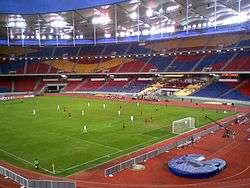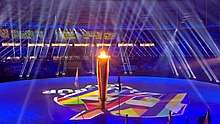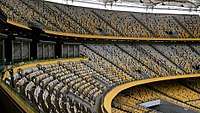Bukit Jalil National Stadium
 The stadium during 2014 AFF Championship. | |
| Location | Bukit Jalil, Kuala Lumpur, Malaysia |
|---|---|
| Coordinates | 3°3′16.8″N 101°41′28.2″E / 3.054667°N 101.691167°E |
| Public transit | SP17 Bukit Jalil LRT station |
| Owner | Malaysian Government |
| Operator | National Sports Complex |
| Capacity | 87,411[1] |
| Field size | 105 by 68 m (344 by 223 ft) |
| Surface |
Grass pitch Track |
| Scoreboard | LED Panel by Samsung |
| Construction | |
| Opened | 11 September 1996 |
| Renovated |
1 January 1998 July 2017 |
| Expanded | 1 January 1998 |
| Construction cost | RM800 million[2] |
| Architect |
Arkitek FAA Weidleplan Consulting Gmbh Schlaich Bergermann Partner Populous (2017 renovation) |
| Main contractors |
UEM Group Malaysian Resources Corporation Berhad (2017 renovation) |
| Tenants | |
| Malaysia national football team | |
The Bukit Jalil National Stadium (Malay: Stadium Nasional Bukit Jalil) in Bukit Jalil, located in the National Sports Complex to the south of the city centre of Malaysia's capital city, Kuala Lumpur, all-seater multi-purpose stadium and the home ground of the Malaysian national football team. With a capacity of 87,411,[3] it is the largest in Southeast Asia and the ninth largest football stadium in the world.[4]
It was officially inaugurated by the 4th Prime Minister of Malaysia, Tun Dr. Mahathir Mohamad, on 1 January 1998 ahead of the 1998 Commonwealth Games and staged the opening ceremony.[3][5] Since then, it has also became the main venue for other international multi-sport events such as the 2001 Southeast Asian Games and the 2017 Southeast Asian Games,[6] and nowadays host most Malaysian international football matches, national level football competition finals such as the Malaysia FA Cup, Malaysia Cup, athletic events and music concerts.
It was built alongside other sport venues in the National Sports Complex by United Engineers Malaysia, and designed by Arkitek FAA, Weidleplan Consulting GMBH and Schlaich Bergermann Partner. A membrane structure is used for the roof, and the most of the materials used were reinforced concrete.[7] Before the stadium was opened, Stadium Merdeka was the national stadium of Malaysia.
The stadium, along with the National Sports Complex, is currently undergoing a major renovation at a combined cost of RM1.34 billion[8] as a part of KL Sports City project in 2 phases. Project 1 (Phase 1) has been completed ahead and for the 2017 SEA Games in Kuala Lumpur, with a new Populous-designed facade that covers the exterior of the stadium with twisted vertical louvres which are also LED-lighted,[9] as well as recolouring the seats to a yellow-black design and upgraded facilities. After the 2017 ASEAN Para Games, Project 2 (Phase 2) will commence, and will add a retractable roof, retractable seats, comfort ventilation and new sports and lifestyle facilities.[10]
History
The stadium was built on 1 January 1995 to host the 1998 Commonwealth Games. It finished exactly on 1 January 1998. After the 1998 Commonwealth Games in September, the stadium became the home stadium for the Malaysia national football team, replacing the Shah Alam Stadium and the Merdeka Stadium. It also served as the main stadium of the 2001 Southeast Asian Games, 2006 FESPIC Games, 2008 ASEAN University Games and 2017 Southeast Asian Games.
Bukit Jalil National Stadium's capacity makes it the 21 largest stadium in the world and the 9th largest football stadium in the world. It was built by United Engineers Malaysia, Bhd and designed by Arkitek FAA. It was completed three months ahead of schedule. Designed to host a multitude of events, the National Stadium is the central and most prominent sports venue at the 1.2 km² National Sports Complex in Bukit Jalil. The stadium is considered the best stadium in Malaysia.
Malaysia's previous national stadium was the Merdeka Stadium before the Bukit Jalil sports complex was constructed. Malaysia also uses other stadiums for their football matches such as KLFA Stadium, MBPJ Stadium and the Shah Alam Stadium.
Stadium facilities
The stadium is equipped with the following facilities:[11]
- 105 m x 68 m grass pitch
- 9 laned 400m synthetic track
- 6m x 60m warming up track
- 1,500 flux floodlights
- Broadcast Studios
- Coloured Video Matrix Scoreboards
- High-tech Cathode Ray Tube Video Screen Board
- Individual "paddles" containing LED pixels at the seats
Other uses
Bukit Jalil National Stadium has been host to other important events besides football matches. Notable music artists who have performed in the stadium include:
- Jacky Cheung "The Year of Jacky Cheung" World Tour Concert “光年世界巡回演唱會” 大马站,14 September 2007.
- Jacky Cheung "Music Odyssey" World Tour Concert “音乐之旅演唱會” 大马站, 23 March 2002.
- Jacky Cheung Live In Malaysia Concert “友个人演唱會” 大马站,23 April 1999.
- Rain Rain's Coming World Tour, 27 January 2007.
- The Corrs Talk on Corners World Tour and In Blue.
- A-Mei Star Tour Concert.
- Wang Lee Hom Music Man Tour 2009.
- Good Charlotte (MTV Event).
- S.H.E 奇幻樂園吉隆坡演唱會 (Fantasy Land World Tour), 6 November 2004.
- S.H.E 愛而為一馬來西亞演唱會 (S.H.E is the One World Tour), 6 March 2010.
- Kelly Clarkson All I Ever Wanted Tour, April 2010.
- Fish Leong "Today is our Valentine's Day 今天情人节" Live in Malaysia, 13 June 2009.
- Fish Leong "Love Parade 爱的大游行" Live in Malaysia, 1 October 2005.
- Usher Live in Malaysia, July 2010.
- Paramore Brand New Eyes World Tour, 19 October 2010.
- G-Dragon 1st World Tour: One Of A Kind, 22 June 2013.
- Linkin Park Living Things World Tour, 19 August 2013.
Major sporting events
- Athletics (track and field) – 1998 Commonwealth Games, 2001 Southeast Asian Games, 2001 ASEAN Para Games, 2008 ASEAN University Games, 2009 ASEAN Para Games, 2015 ASEAN Civil Service Games, 2017 Southeast Asian Games, and 2017 ASEAN Para Games.
- Malaysia Cup finals
- Malaysian FA Cup finals
- 2003 FA Premier League Asia Cup
- 2007 AFC Asian Cup
- 2007 Champions Youth Cup
- Manchester United 2001, 2009 Asia Tour
- 2010 AFF Championship, first leg Finals
- Liverpool F.C. Asia Tour 2011
- Chelsea F.C. 2011 summer tour of Asia[12]
- Arsenal F.C. 2011, 2012 Pre-Season Asia Tour[13]
- Franciscan Super Cup Final 2013
- 2014 AFF Championship second leg Finals
- Liverpool F.C. 2nd Asia Tour 2015
Gallery
 The stadium in 2007.
The stadium in 2007. The interior of the stadium during the opening ceremony of the 2017 Southeast Asian Games. The seats were equipped with lighting "paddles" containing LED pixels.
The interior of the stadium during the opening ceremony of the 2017 Southeast Asian Games. The seats were equipped with lighting "paddles" containing LED pixels. The cauldron of the 2017 Southeast Asian Games inside the stadium.
The cauldron of the 2017 Southeast Asian Games inside the stadium. All brand-new seats after renovation during 2017 Southeast Asian Games
All brand-new seats after renovation during 2017 Southeast Asian Games
See also
References
| Wikimedia Commons has media related to Stadium Nasional Bukit Jalil. |
- ↑ http://www.worldstadiumdatabase.com/bukit-jalil-national-stadium-stadium-kuala-lumpur-in-malaysia.htm
- ↑ "Bukit Jalil National Stadium - Malaysia | Football Tripper". Football Tripper. 12 July 2014. Retrieved 26 August 2017.
- 1 2 "National Sport Complex". kiat.net. Archived from the original on 16 November 2012. Retrieved 16 December 2012.
- ↑ "The Largest Football (Soccer) Stadiums In The World". WorldAtlas. Retrieved 25 August 2017.
- ↑ "Perbadanan Stadium Malaysia - National Stadium".
- ↑ "KL to be main venue for 2017 SEA Games". Free Malaysia Today. Retrieved 25 August 2017.
- ↑ "National Stadium, Bukit Jalil (Kuala Lumpur, 1997) | Structurae". Structurae. Retrieved 26 August 2017.
- ↑ "MRCB's subsidiary hands over Project 1 of KL Sports City - Business News | The Star Online". www.thestar.com.my. Retrieved 26 August 2017.
- ↑ "KL Sports City Rejuvenated And Ready To Host The South East Asian Games | POPULOUS". POPULOUS. Retrieved 26 August 2017.
- ↑ "Supplemental pact for 2nd phase of KL Sports City project delayed - Business News | The Star Online". www.thestar.com.my. Retrieved 26 August 2017.
- ↑ "Perbadanan Stadium Malaysia - Bukit Jalil National Sports Complex". Archived from the original on 3 December 2014.
- ↑ Return Journey to Kuala Lumpur Retrieved at 8 June 2014
- ↑ "Arsenal to undertake pre-season tour of Malaysia and China this July". guardian.co.uk. 24 May 2011. Retrieved 13 December 2012.
| Preceded by Centennial Stadium |
Host of the Commonwealth Games 1998 |
Succeeded by City of Manchester Stadium |
| Preceded by None |
Premier League Asia Trophy Venue 2003 |
Succeeded by Rajamangala Stadium |
Coordinates: 3°3′16.8″N 101°41′28.2″E / 3.054667°N 101.691167°E